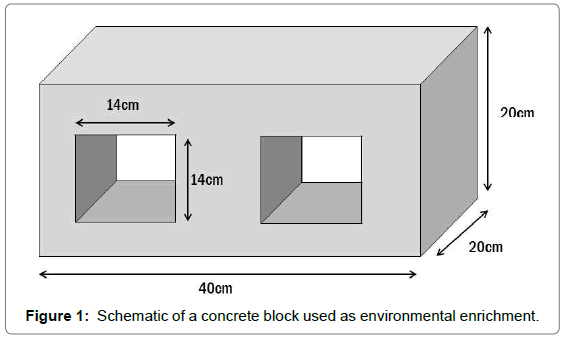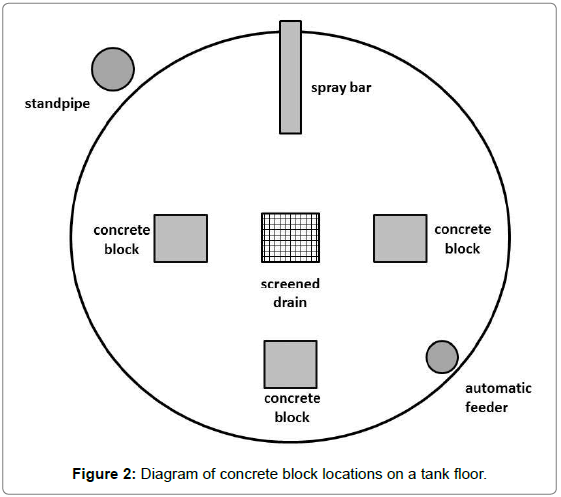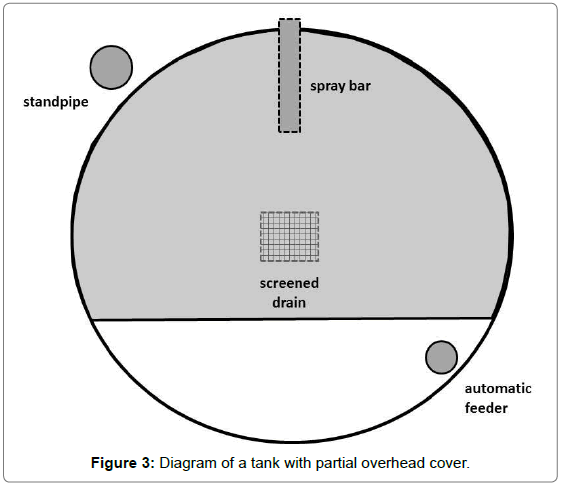Use of Bottom Structure and Tank Cover during Rainbow Trout Rearing in Circular Tanks
Received: 01-Aug-2017 / Accepted Date: 30-Aug-2017 / Published Date: 04-Sep-2017 DOI: 10.4172/2332-2608.1000247
Abstract
The use of environmental enrichment has been found to be beneficial in fish rearing performance and behavior. This study evaluated the effects of partial overhead cover and rearing tank substrate on the hatchery performance of juvenile rainbow trout Oncorhynchus mykiss. Four treatments were used in circular tanks: open tanks with concrete blocks, partially-covered tanks with blocks, open tanks with no concrete blocks, and partially-covered tanks with no blocks. There was no significant effect of concrete block substrate use on rainbow trout weight gain or feed conversion ratio. However, fish reared with overhead cover had a significant weight gain increase and a significant feed conversion ratio decrease compared to uncovered tanks. There was no significant interaction between cover and substrate. The use of overhead cover is recommended to increase trout rearing performance in circular tanks.
Keywords: Environmental enrichment; Tank structure; Fish rearing; Hatchery rearing
Abbreviations
SD: Standard Deviation; FCR: Feed Conversion Ratio
Introduction
Salmonids in their natural environment use structures such as rocks and logs as cover [1], suggesting that the enhancement of relativelysterile hatchery rearing environments with submerged structures may be beneficial. Previous studies examining environmental enrichment techniques have noted that the addition of structure may increase competitive behavior and foraging skills in domesticated fish [2-4] as well as improve fish swimming ability and adaptability to new environments [5]. Vertically-suspended structure has also been observed to improve fish weight gain during hatchery rearing [6].
While the effect of environmental enrichment on rearing performance and post-stocking acclimation may be beneficial for fish, many aspects of adding structure to rearing tanks make it unreasonable for hatcheries to implement these techniques. For example, many studies have placed natural materials such as woody debris, plants, and root wads on the bottom of hatchery rearing tanks [2,7-11], but those materials may interfere with the self-cleaning nature of circular rearing tanks by altering water flow patterns. This leads to more frequent tank cleanings because of an increase of food and feces trapped in structures [12]. In addition, the presence of substrate in tanks allows for more area for pathogens to survive [13].
Research on environmental enrichment techniques other than inwater structure, particular those involving overhead cover, has also been conducted. Trout show a definite preference for cover in artificial tanks [14]. The use of partial and near-total overhead cover during hatchery rearing has been shown to improve trout growth and feed conversion [15-17], as well as improve fish health [18]. An evaluation of both overhead cover and in-water structure has not occurred.
The objective of this study was to evaluate the effects on juvenile rainbow trout Oncorhynchus mykiss rearing performance in circular tanks with bottom structure (concrete blocks) and partial overhead covers when used alone and when used in combination.
Materials and Methods
The experiment was conducted at McNenny State Fish Hatchery, rural Spearfish, South Dakota, USA using well water (11°C; water hardness as CaCO3-360 mg/L; alkalinity as CaCO3-210 mg/L; pH-7.6; total dissolved solids-390 mg/L). Twelve circular fiberglass tanks (1.8 m diameter and 0.8 m deep) were used with four different treatments (N=3): open tanks with concrete blocks, partially-covered tanks with blocks, open tanks with no concrete blocks, and partially-covered tanks with no blocks. The concrete blocks were commercially-available, standard construction blocks (Figure 1). Tanks that contained concrete blocks each had three blocks equilaterally spaced on the bottom of the tank (Figure 2). Partial tank covers were similar to those confstructed and described by Walker et al. [17].
On 7 November, 2014, 2,000 (2.72 kg) rainbow trout (mean ± SD, weight 1.36 ± 0.32 g, length 50 ± 4 mm; N=30) were placed into each of the 12 tanks. Feeding commenced the following day with 2.5 mm classic trout diet (Skretting, Tooele, Utah, USA). Feed was dispensed with an automatic feeder every 15 minutes during daylight hours. Fish were fed to apparent satiation, with feeding rates based on the hatchery constant method [19]. Fish were reared for ten weeks with a projected growth rate of 0.080 cm/day and an anticipated feed conversion ratio of 1.1. A total of 17.01 kg was fed to each of the tanks. At the beginning and end of the experiment, fish length was recorded to the nearest 1.0 mm and weight to the nearest 0.01 g. Total tank weights to the nearest 0.01 kg were obtained at the beginning and the end of the experiment using an Ohaus model T1XW scale (Parsippany, New Jersey, USA). Tanks were cleaned weekly with mortalities removed and recorded daily. Tanks received ambient light from 0.5 m high translucent panels located just below the tank room ceiling. Overhead electric lights were only turned on daily for approximately 15 minutes during tank cleaning and mortality removal. All tanks were cleaned on the same schedule, predicated by observable waste accumulation on or near the screen (Figure 3).
The following equations were used:
Weight gain=end tank weight - start tank weight
Feed conversion ratio=feed fed/weight gain.
Data were analyzed using the SPSS (9.0) statistical analysis program (SPSS, Chicago, Illinois, USA) with significance predetermined at P
Results
There were no significant effects of concrete block use on end tank weight, tank weight gain, or feed conversion ratio (Table 1). There was a significant effect on the use of partial tank covers on end tank weight, tank weight gain, and feed conversion ratio. Tanks with partial covers experienced approximately a 5% increase in weight gain and a 5% decrease in feed conversion ratio. There was no significant interaction between the tank cover and concrete block treatments. Individual fish lengths and weights were also not significantly different between the treatments (Table 2). Mortality, while nearly 10%, was not significantly impacted by the use of overhead covers or concrete blocks. Fish waste was observed to accumulate on the bottom of the tanks with concrete blocks, and was absent from all other treatments.
| Treatment | End weight (kg) | Weight gain (kg) | FCR | % Mortality |
|---|---|---|---|---|
| Cover absent | 15.37 (0.30) z | 12.66 (0.30) z | 1.34 (0.03) z | 12.5 (4.5) |
| Cover present | 16.05 (0.37) y | 13.33 (0.37) y | 1.28 (0.04) y | 9.7 (5.0) |
| Blocks absent | 15.66 (0.46) | 12.94 (0.46) | 1.32 (0.05) | 10.3 (3.9) |
| Blocks present | 15.77 (0.52) | 13.05 (0.52) | 1.31 (0.05) | 11.8 (5.8) |
Means in a column within a treatment with different letters are significantly different (N = 6, P < 0.05).
Table 1: Mean (SD) total tank ending weight, weight gain, feed conversion ratio (FCR), and percent mortality from tanks of rainbow trout reared with partial-overhead cover and/or concrete blocks as in-tank structure.
| Treatment | Weight (g) | Length (mm) |
|---|---|---|
| Cover absent | 9.00 (2.17) | 91.0 (8.1) |
| Cover present | 7.92 (1.02) | 88.3 (5.4) |
| Blocks absent | 7.95 (1.94) | 87.7 (7.7) |
| Blocks present | 9.04 (1.56) | 91.6 (5.6) |
Table 2: Mean (SD) lengths and weights from individual rainbow trout reared with partial-overhead cover and/or concrete blocks as in-tank structure (N=6).
Discussion
Adding substrate to the tank floor did not lead to any significant improvements in fish rearing performance. These results are similar to Brockmark et al. [9], who found no significant difference in fish rearing performance with the addition of plastic plants and rocks to tank bottoms. Although neither this study nor Brockmark et al. [9] found significant benefit with the use of environmental enrichment, benefits from the addition of structure in tanks has been found in other studies [2,6]. One difference that could account for the significant results of Kientz and Barnes [6] is the placement of structure in the tank. Both this study and Brockmark et al. [9] added structure to the tank floor while Kientz and Barnes [6] suspended structure from tank covers. As also observed by Baynes and Howell [13], the presence of the concrete blocks in this study interfered with the self-cleaning nature of circular tanks by trapping feces on the bottom of the tanks, thus requiring more frequent tank cleanings.
Although structure may provide extra surface area to harbor pathogens or fecal matter [12,13], there was no difference in mortality among the treatments. Although fecal matter did accumulate, the concrete may have not been a suitable substrate for bacterial growth or bacteria endemic to the concrete may have competitively displaced pathogen bacteria [20]. Additionally, the limited number of the relatively smooth blocks, and their design with two large holes may not have provided enough surface area protected from the current to produce excessive microbial growth [21].
The use of tank covers improved rearing performance in this study. Several other studies have also noted improvements in trout growth and feed conversion with the use of partial overhead cover [15-17]. In contrast, Wagner and Bosakowski [14] found no significant difference between fish reared in covered raceways compared to uncover raceways. The discrepancies in findings between Wagner and Bosakowski [14] and this study may be due to differences in the rearing units and amounts of overhead cover used. Specifically, Wagner and Bosakowski [14] used large outdoor raceways while this study used indoor circular tanks.
The use of environmental enrichment can be beneficial during salmonid rearing [2,6], but not all enrichment techniques are equally effective in improving fish rearing performance. The use of concrete blocks on tank floors as a method of enrichment is not recommended because of a lack of significant effect on fish growth, as well as increased demands on routine cleaning. The use of cover is recommended as a beneficial technique for fish rearing performance with minimal interference with tank cleaning.
Acknowledgements
We thank Kati Krebs, Wyatt Krebs, Patrick Nero, and Tim Parker for their assistance with this study.
References
- Devore PW, White RJ (1978) Daytime responses of brown trout (Salmo trutta) to cover stimuli in stream channels. Transactions of the American Fisheries Society 107: 763-771.
- Berejikian BA, Tezak EP, Flagg TA, LaRae AL, Kummerow E, et al. (2000) Social dominance, growth, and habitat use of age-0 steelhead (Oncorhynchus mykiss) grown in enriched and conventional hatchery rearing environments. Canadian Journal of Fisheries and Aquatic Sciences 57: 628-636.
- Rodewald P, Hyvärinen P, Hivonen H (2011) Wild origin and enriched environment promote foraging rate and learning to forage on natural prey of captive reared Atlantic Salmon parr. Ecology of Freshwater Fish 20: 569-579.
- Tatara CP, Riley SC, Scheurer JA (2008) Environmental enrichment in steelhead (Oncorhynchus mykiss) hatcheries: field evaluation of aggression, foraging, and territoriality in natural and hatchery fry. Canadian Journal of Fisheries and Aquatic Sciences 65: 744-753.
- Bergendahl A, Miller S, Depasquale C, Giralico L, Braithwaite VA (2016) Becoming a better swimmer: structural complexity enhances agility in captive-reared fish. Journal of Fish Biology.
- Kientz JL, Barnes ME (2016) Structural complexity improves the rearing performance of rainbow trout in circular tanks. North American Journal of Aquaculture 78: 203-207.
- Berejikian BA, Smith RJF, Tezak EP, Schroder SL, Knudsen CM (1999) Chemical alarm signals and complex hatchery rearing habitats affect antipredator behavior and survival of Chinook salmon (Oncorhynchus tshawytscha) juveniles. Canadian Journal of Fisheries and Aquatic Sciences 56: 830-838.
- Berejikian BA, Tezak EP (2005) Rearing in enriched hatchery tanks improves dorsal fin quality of juvenile steelhead. North American Journal of Aquaculture 67: 289-293.
- Brockmark S, Neregård L, Bohlin T, Björnsson BT, Johnsson JI (2007) Effects of rearing density and structural complexity on pre- and postrelease performance of Atlantic salmon. Transactions of the American Fisheries Society 136: 1453-1462.
- Fast DE, Neeley D, Lind DT, Johnston MV, Strom CR, et al. (2008) Survival comparison of spring Chinook Salmon reared in a production hatchery under optimum conventional and seminatural conditions. Transactions of the American Fisheries Society 137: 1507-1518.
- Roberts LJ, Taylor J, Garcia de Leaniz C (2011) Environmental enrichment reduces maladaptive risk-taking behavior in salmon reared for conservation. Biological Conservation 144: 1972-1979.
- Baynes SM, Howell BR (1993) Observations on the growth, survival and disease resistance of juvenile common sole, Solea solea (L.), Mytilus edulis L. Aquaculture and Fisheries Management 24: 95-100.
- Tuckey LM, Smith TI (2001) Effects of photoperiod and substrate on larval development and substrate preference of juvenile Southern flounder, Paralichthys lethostigma. Journal of Applied Aquaculture 11: 1-20.
- Wagner EJ, Bosakowski T (1994) Performance and behavior of rainbow trout reared in covered raceways. The Progressive Fish-Culturist 56: 123-9.
- Barnes ME, Durben DJ (2003) Use of partial tank covers during hatchery rearing of feral rainbow trout. North American Journal of Aquaculture 65: 344-348.
- Barnes ME, Miller J, Durben DJ (2005) Partial overhead tank cover use during feral brown trout rearing. North American Journal of Aquaculture 67: 319-323.
- Walker LM, Parker TM, Barnes ME (2016) Full and partial overhead tank cover improves rainbow trout rearing performance. North American Journal of Aquaculture 78: 20-24.
- Corson BW, Brezosky PE (1961) Hatchery production experiment designed to prevent sunburn in landlocked salmon. The Progressive Fish-Culturist 23: 175-178.
- Buterbaugh GL, Willoughby H (1967) A feeding guide for brook, brown, and rainbow trout. Progressive Fish-Culturist 29: 210-215.
- Li VC, Herbert E (2012) Robust self-healing concrete for sustainable infrastructure. Journal of Advanced Concrete Technology 10: 207-18.
- Donlan RM (2002) Biofilms: microbial life on surfaces. Emerging infectious diseases 8: 881.
Citation: Crank KM, Krebs J, Krebs E, Barnes ME (2017) Use of Bottom Structure and Tank Cover during Rainbow Trout Rearing in Circular Tanks. J Fisheries Livest Prod 5: 247 DOI: 10.4172/2332-2608.1000247
Copyright: © 2017 Crank KM, et al. This is an open-access article distributed under the terms of the Creative Commons Attribution License, which permits unrestricted use, distribution, and reproduction in any medium, provided the original author and source are credited.
Select your language of interest to view the total content in your interested language
Share This Article
Recommended Journals
Open Access Journals
Article Tools
Article Usage
- Total views: 5045
- [From(publication date): 0-2017 - Dec 12, 2025]
- Breakdown by view type
- HTML page views: 4118
- PDF downloads: 927



